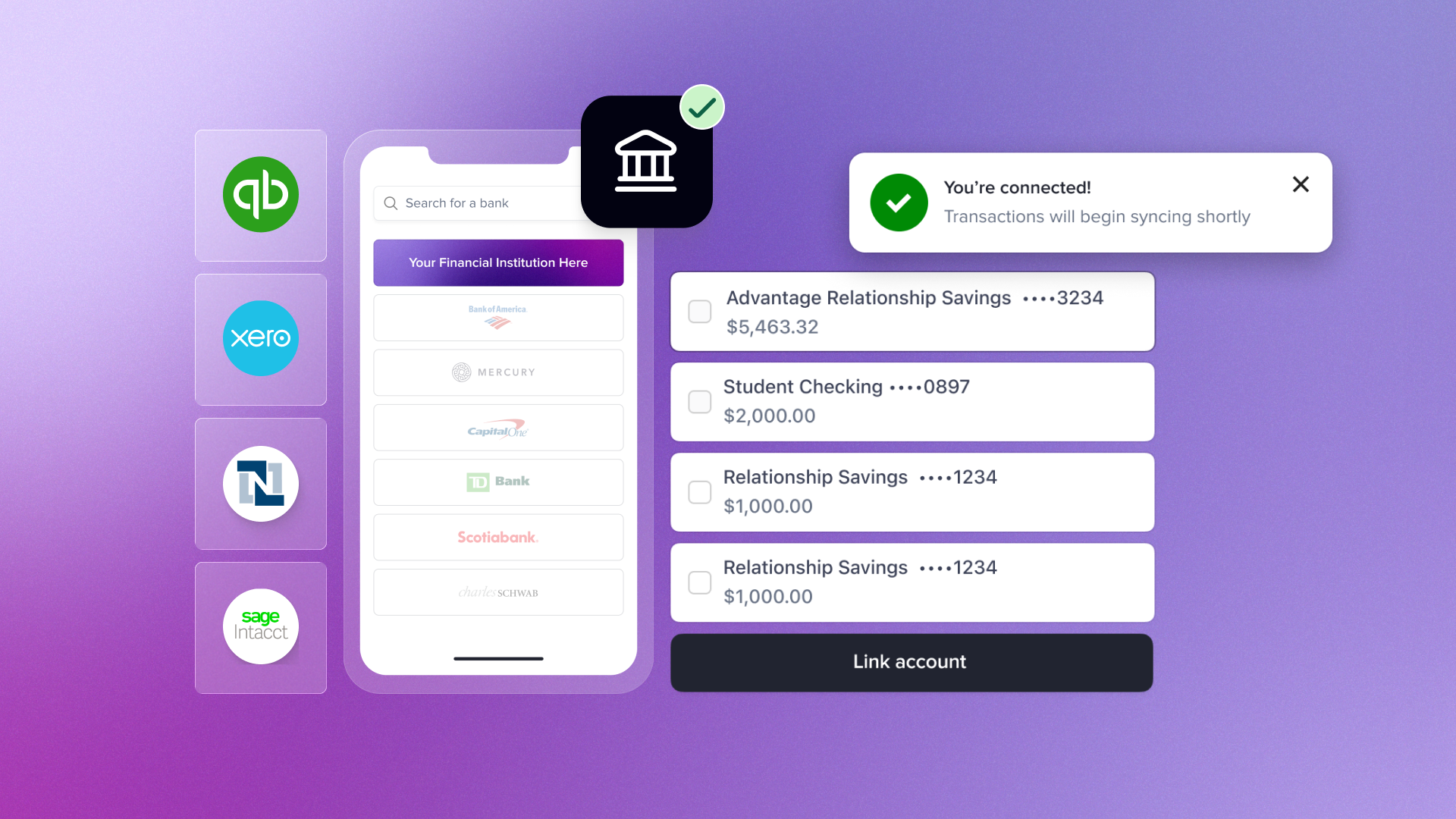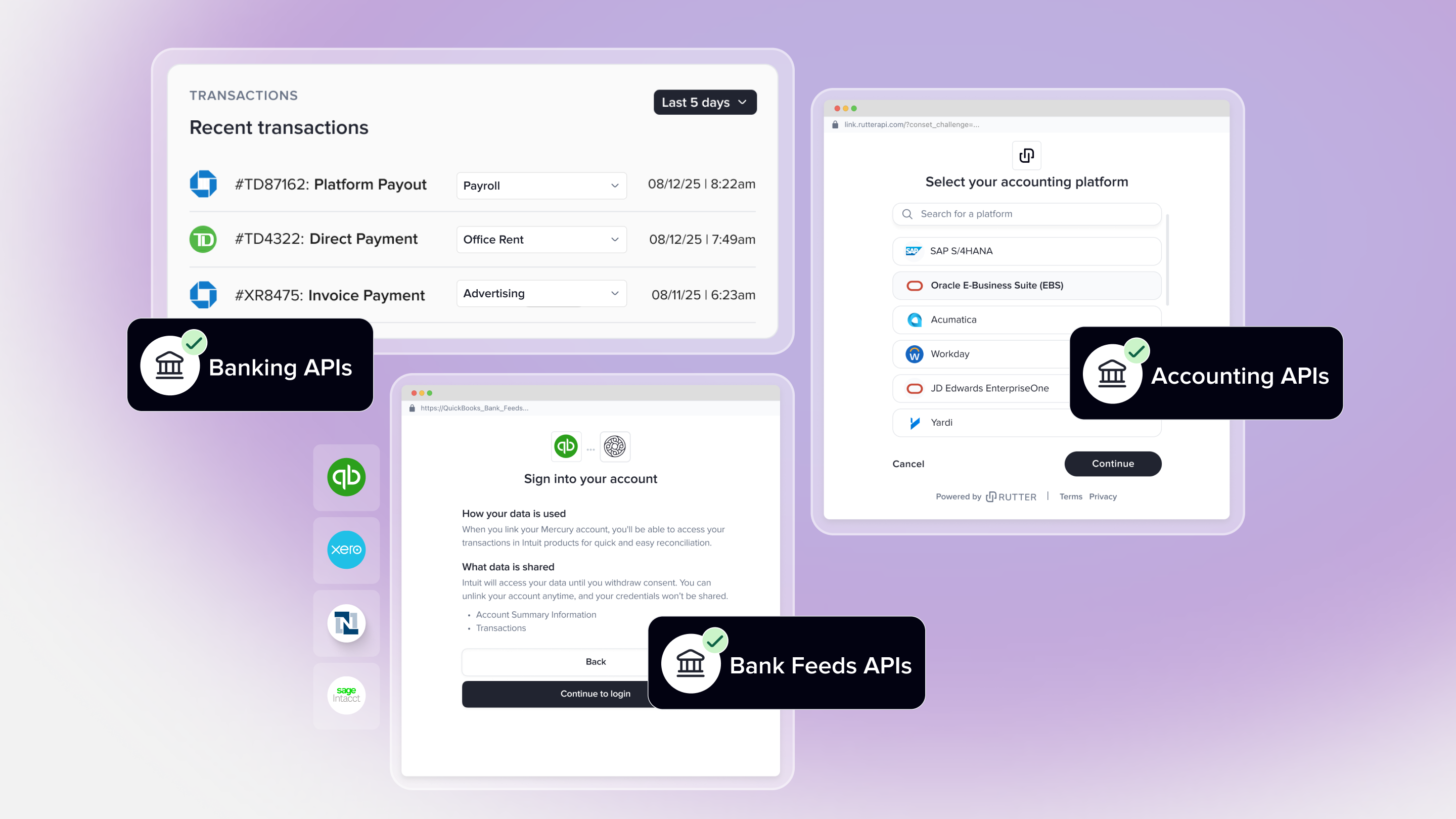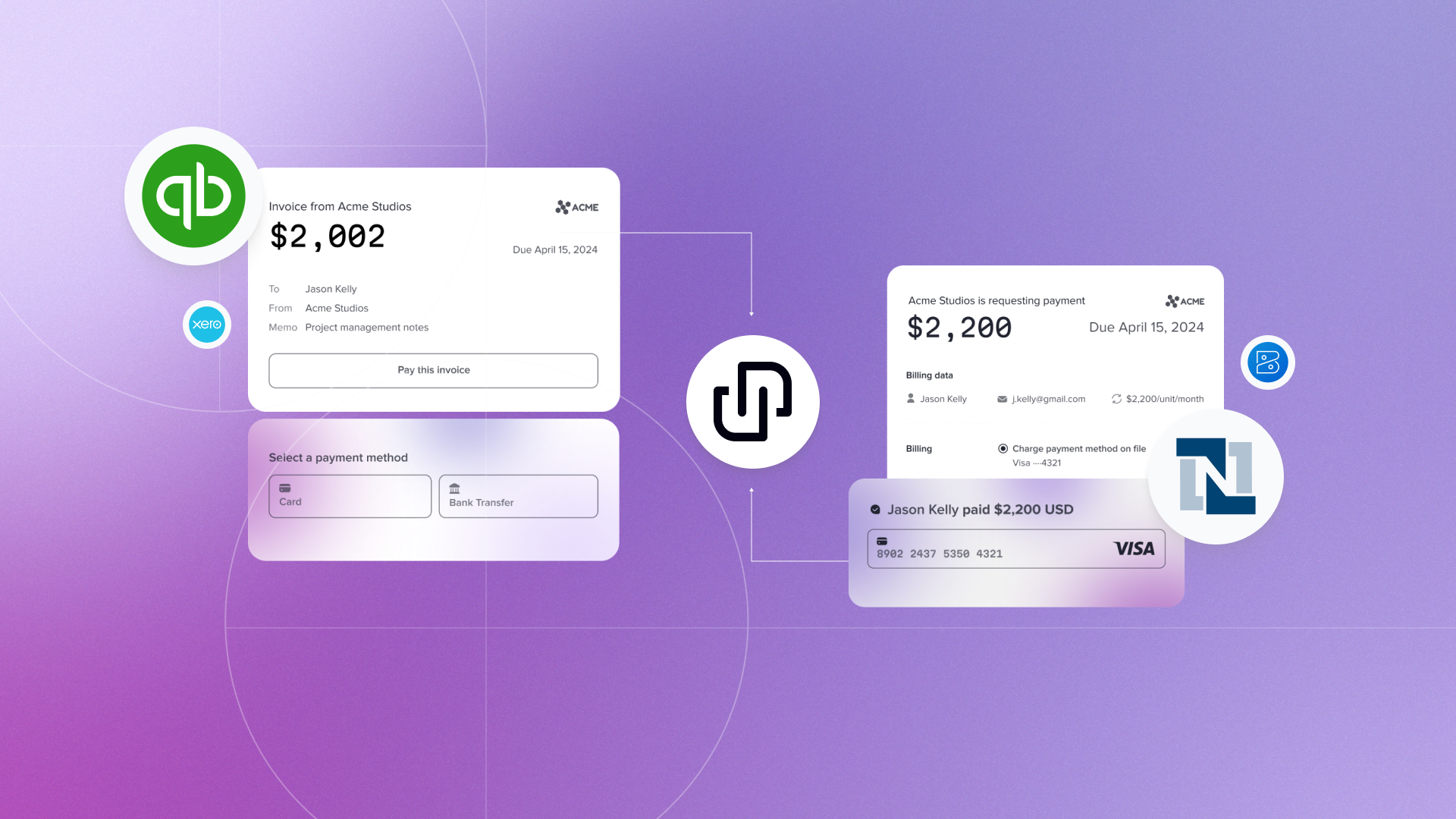
Your business customers are tired of manually downloading CSV files and importing transactions into QuickBooks every month. They're asking why connecting to your bank isn't as seamless as connecting to Chase or Wells Fargo in their accounting software. If you're a financial institution serving business customers, bank feeds have quietly become the difference between winning and losing commercial accounts.
What Are Bank Feeds?
Bank feeds are automated connections that sync transactions from a financial institution directly into accounting software like QuickBooks, Xero, or NetSuite. Instead of businesses manually downloading CSV files and importing them month after month, bank feeds create a real-time pipeline that automatically pushes transaction data into their books.
When your customer makes a purchase with their corporate card or transfers money from their business account, bank feeds enable that transaction to automatically appear in their accounting system within hours. It's categorized, reconciled, and ready for their month-end close.
For businesses, this automation eliminates hours of manual data entry, reduces errors, and provides real-time visibility into their financial position. For financial institutions, offering bank feeds has become table stakes for winning and retaining business customers.
Why Bank Feeds Matter for Financial Institutions
The numbers tell the story. According to recent industry research, 76% of U.S. consumers agree that "when choosing a bank, the ability to connect my accounts to apps and services I want to use is a top priority." Even more telling, 69% of Americans said they "would consider switching banks if my primary bank could not connect to my financial account."
Whether you're a traditional bank, credit union, or emerging fintech, bank feeds represent a massive competitive differentiator. Regional banks are losing commercial customers to digital-first institutions that offer seamless accounting integrations. Fintech companies like Flex, Mercury, and Aspire have made bank feeds central to their value proposition, allowing their customers to seamlessly sync card and banking transactions into whatever accounting system they use.
Without bank feeds, your customers face a painful monthly ritual. They log into your platform, download transaction CSVs, manually import them into their accounting software, and then spend hours categorizing and reconciling everything. It's time-consuming, error-prone, and can feel archaic in 2025.
How Traditional Banks Get Listed in Accounting Software
When you open QuickBooks or Sage and look for your bank in the "Connect Your Bank" flow, you'll see major institutions like Chase, Wells Fargo, and Bank of America prominently listed. These banks didn't get there by accident. They've invested significant time and resources into partnerships with accounting software providers.
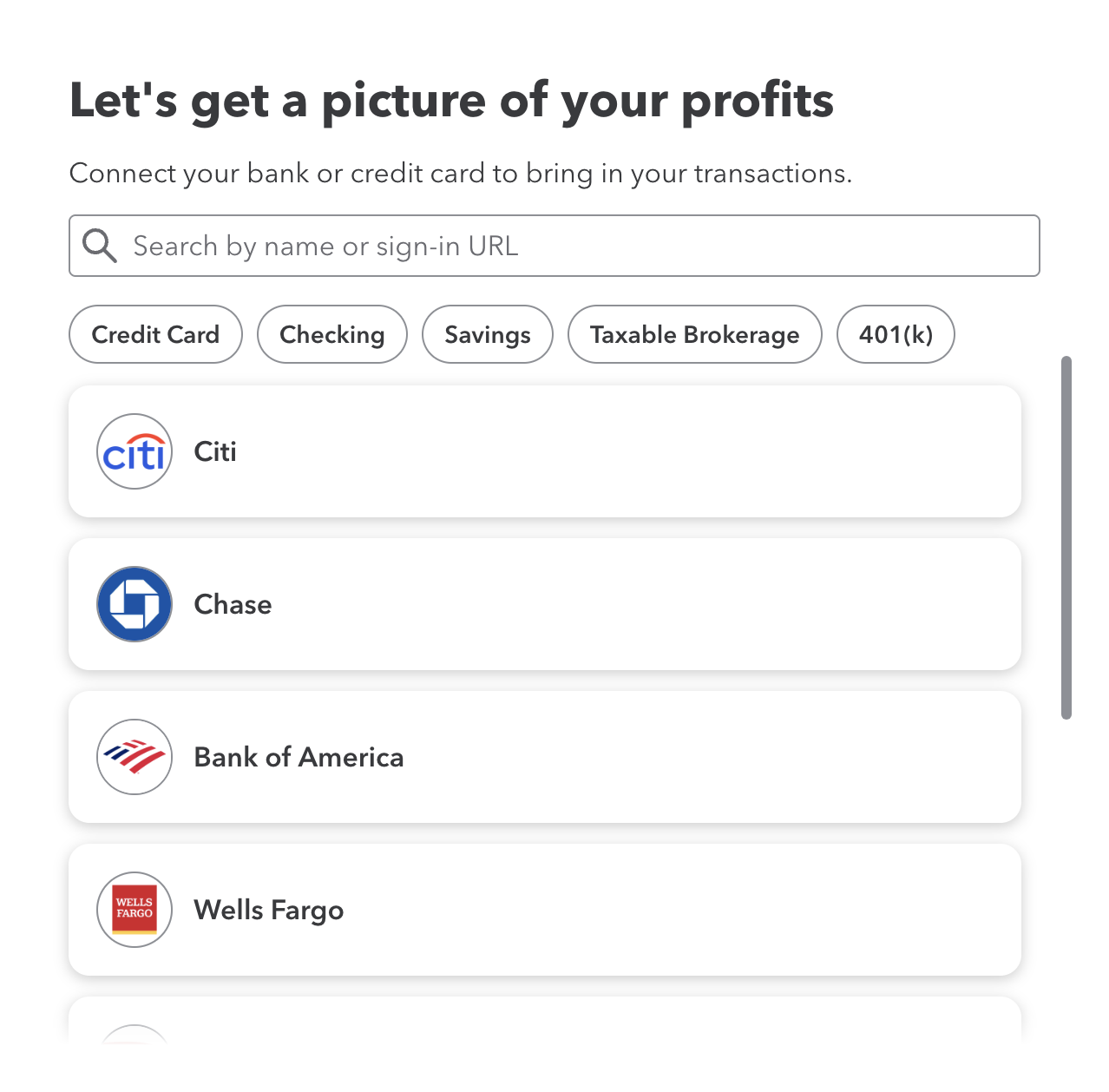
Partnership development comes first. Banks must establish formal business relationships with each accounting platform. This involves legal agreements, compliance reviews, and ongoing relationship management. For some major platforms, the partnership process can take over a year.
Once that hurdle is cleared, the next step is technical integration. Each platform has its own proprietary API and technical requirements. Banks need to build and maintain separate integrations for QuickBooks, Xero, Sage, NetSuite, and every other platform their customers use that they wish to offer bank feeds for. This often leads to banks supporting just one or two platforms.
Finally, the maintenance never ends. Even if every technical requirement was implemented perfectly at launch, APIs change, platforms change over time, and new features need to be supported. Banks maintain dedicated teams to keep these integrations running smoothly.
For some traditional banks with massive engineering teams and established partnership channels, this approach works but requires significant ongoing investment. For smaller banks and fintechs, this approach is prohibitively expensive and slow.
Why Most Financial Institutions Can't Get Listed Directly
The harsh reality is that most accounting platforms aren't eager to work with every bank or fintech that wants to offer bank feeds.
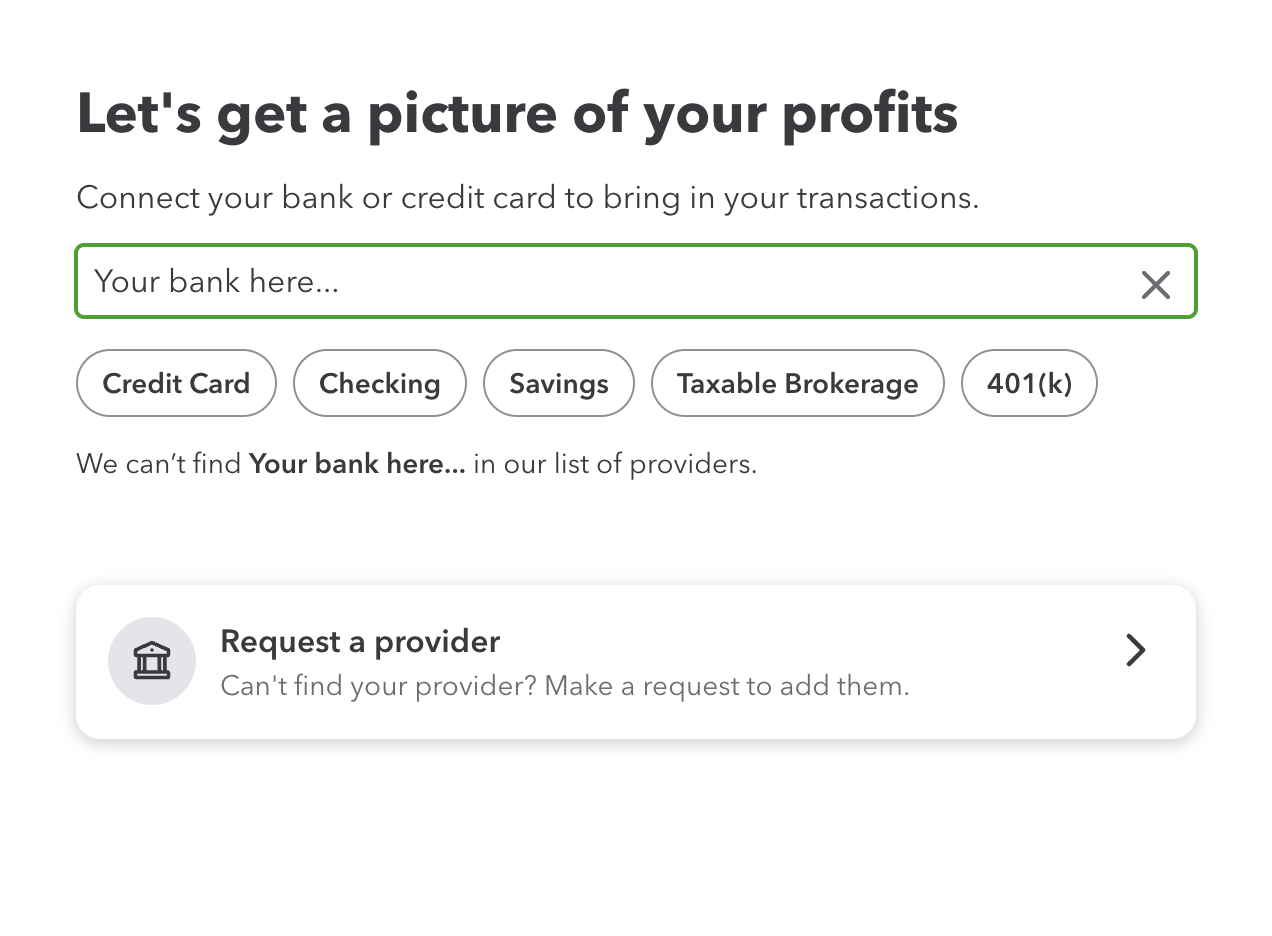
Resource constraints are a major factor. Platforms like Intuit and Sage receive hundreds of partnership requests. They prioritize relationships with large, established financial institutions that can drive significant transaction volume and create the value for the largest number of their platform’s customers.
Technical overhead is another issue. Each new partner requires integration work, testing, and ongoing support. Accounting platforms prefer working with a smaller number of high-volume partners rather than managing dozens of smaller relationships.
Compliance and security requirements create additional barriers. Financial data integrations require rigorous security reviews and compliance verification. Smaller banks and emerging fintechs often lack the dedicated teams and regulatory history that accounting platforms require.
Partnership timelines alone can kill momentum. Even when partnerships are approved, the integration process is lengthy. Intuit typically takes 12+ months for full partnership and technical implementation. Sage requires 3-6 months for partnership approval and integration. Xero can take 6-12 months depending on scope and compliance requirements.
For a regional bank trying to compete with digital-first institutions, or a fintech trying to win enterprise customers, waiting over a year to offer bank feeds simply isn't viable.
How Rutter Acts as Your "Listing-as-a-Service" Partner
This is where Rutter's bank feeds solution comes in. Instead of building individual partnerships with each accounting platform, financial institutions can leverage Rutter's existing relationships and infrastructure to get listed across multiple platforms in weeks, not months.
Rutter maintains the partnerships. We've already done the heavy lifting of establishing partnerships with major accounting platforms. Your financial institution gets an expedited “fast lane”, with listings going live in just 2-4 weeks.
Beyond getting to utilize our partnerships, you also get a universal API. You build one integration with Rutter's API, and we handle the platform-specific technical requirements behind the scenes. Right now, we support QuickBooks Online, QuickBooks Desktop, Quicken, Credit Karma, Sage Intacct, Sage Business Cloud, Xero, and NetSuite. We’re always updating our platform list. Building with Rutter gets you access to the 8+ platforms we support today, as well as all the others on our roadmap.
This cross-platform support ensures that you’ll be able to support your customers as they grow. If one of your customers uses QuickBooks today and switches to NetSuite next year, they’ll still get that same seamless bank feeds experience.
What normally takes 12+ months can be live in a month or less with Rutter's bank feeds API.
Bank Feeds vs. Banking APIs vs. Accounting APIs: What's the Difference?
If you're trying to understand where bank feeds fit in the broader ecosystem of financial APIs, you're not alone. There are three main categories of APIs that handle financial data, and they solve very different problems.
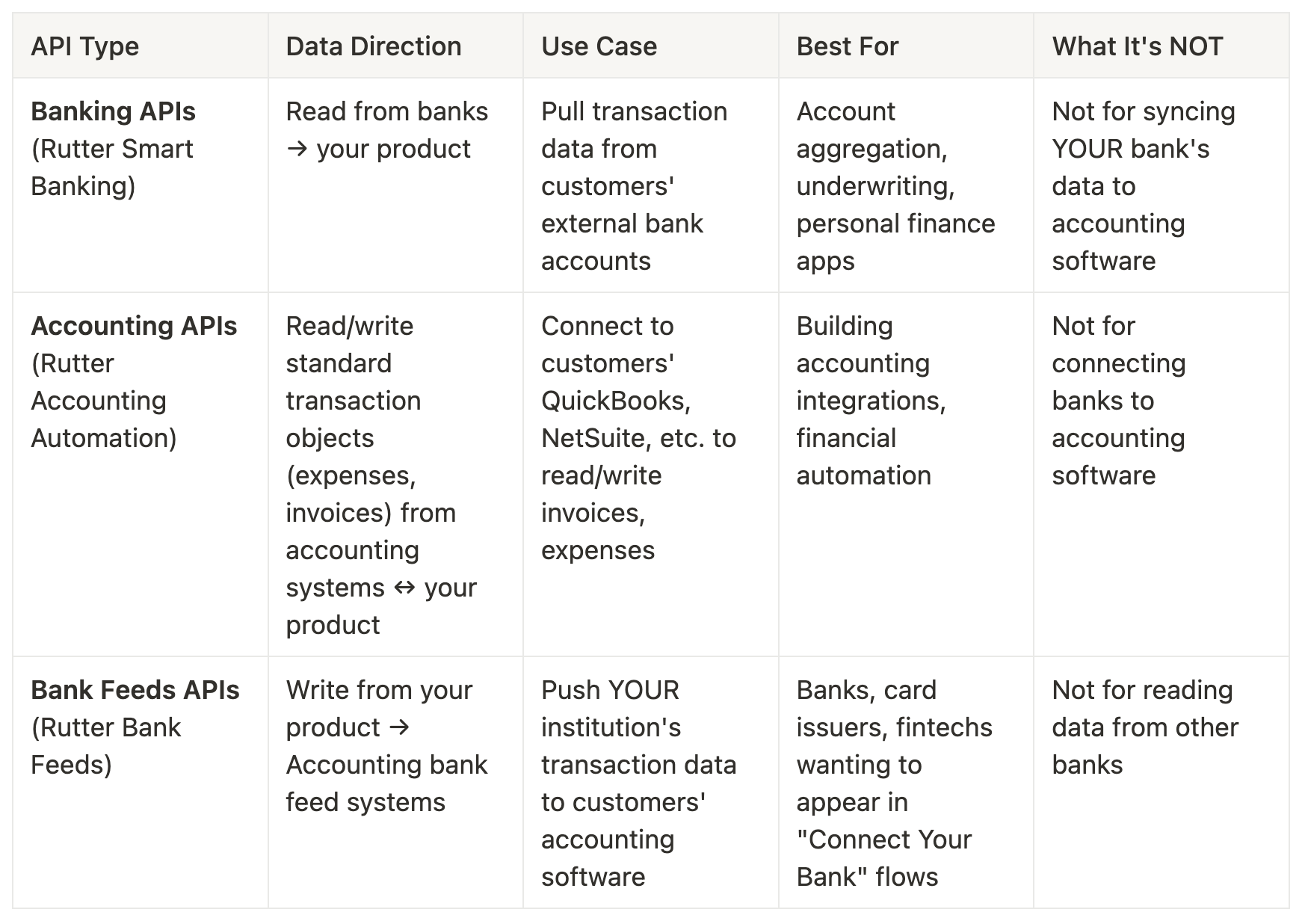
Banking APIs help you pull data FROM other institutions. If you're building a cash management dashboard, you'd use these APIs to read your customer's transactions from their Chase and Wells Fargo accounts.
Accounting APIs help you integrate with accounting platforms. If you're building expense management software, you'd use an accounting API to read and categorize expenses directly in your customer's QuickBooks.
Bank feeds APIs help you push YOUR data TO accounting systems. If you're a bank or card issuer, bank feeds ensure your transactions automatically appear when customers connect their bank in QuickBooks, which they can then reconcile against other entities in their accounting system. You can create entities for them to reconcile their bank feed transactions against using our accounting APIs, providing the best balance of granular data from creating detailed accounting objects and source-of-truth data from bank feeds.
At Rutter, we call our banking data solution "Smart Banking," our accounting integrations "Accounting Automation," and our transaction syncing solution "Bank Feeds." They're complementary but solve different parts of the financial data ecosystem.
The Customer Experience: "Find Your Bank" Flow
When your customers want to connect their accounts, the experience is seamless.
First, they navigate to the bank connection section in their accounting software and search for your institution's name. Your bank appears in the list alongside other major financial institutions. They select your institution and get redirected to your login page to authenticate their account. Then they choose which of their accounts (checking, savings, corporate card, etc.) to sync. Finally, transactions begin flowing automatically into their accounting system.
From the customer's perspective, connecting your institution feels identical to connecting to a major bank like JPMorgan Chase or Wells Fargo. The entire process takes under 5 minutes, and once connected, they never have to think about transaction syncing again.
The Competitive Advantage
Offering bank feeds through Rutter provides several competitive advantages.
Faster time-to-market means while competitors spend months or years building direct integrations, you can offer bank feeds in weeks. Your engineering team can then focus on core differentiators for your product.
Comprehensive coverage lets you support all major accounting platforms through a single integration, rather than picking and choosing based on development resources.
Enterprise sales enablement is crucial. Bank feeds are often a requirement in enterprise RFPs. Having comprehensive accounting integrations can be the difference between winning and losing major deals.
Customer retention improves dramatically. Once customers have their transactions automatically syncing, switching to a competitor becomes significantly more painful.
Your support burden decreases. Automated syncing eliminates customer support tickets about CSV exports, import issues, and reconciliation problems.
Getting Started
Ready to add bank feeds to your financial institution? Rutter's bank feeds API supports the Intuit ecosystem (QuickBooks Online, QuickBooks Desktop, Quicken, and Credit Karma with one integration), Sage platforms (Sage Intacct and Sage Business Cloud), Xero, and NetSuite for enterprise-grade transaction syncing.
Implementation typically takes 2-4 weeks and requires minimal engineering resources. Your customers get enterprise-grade accounting integrations, and you get a massive competitive advantage without the typical 12+ month development cycle.
The question isn't whether your customers want bank feeds. The data shows they absolutely do. The question is whether you'll build this capability in-house over the next year, or deploy it in the next month with Rutter.


